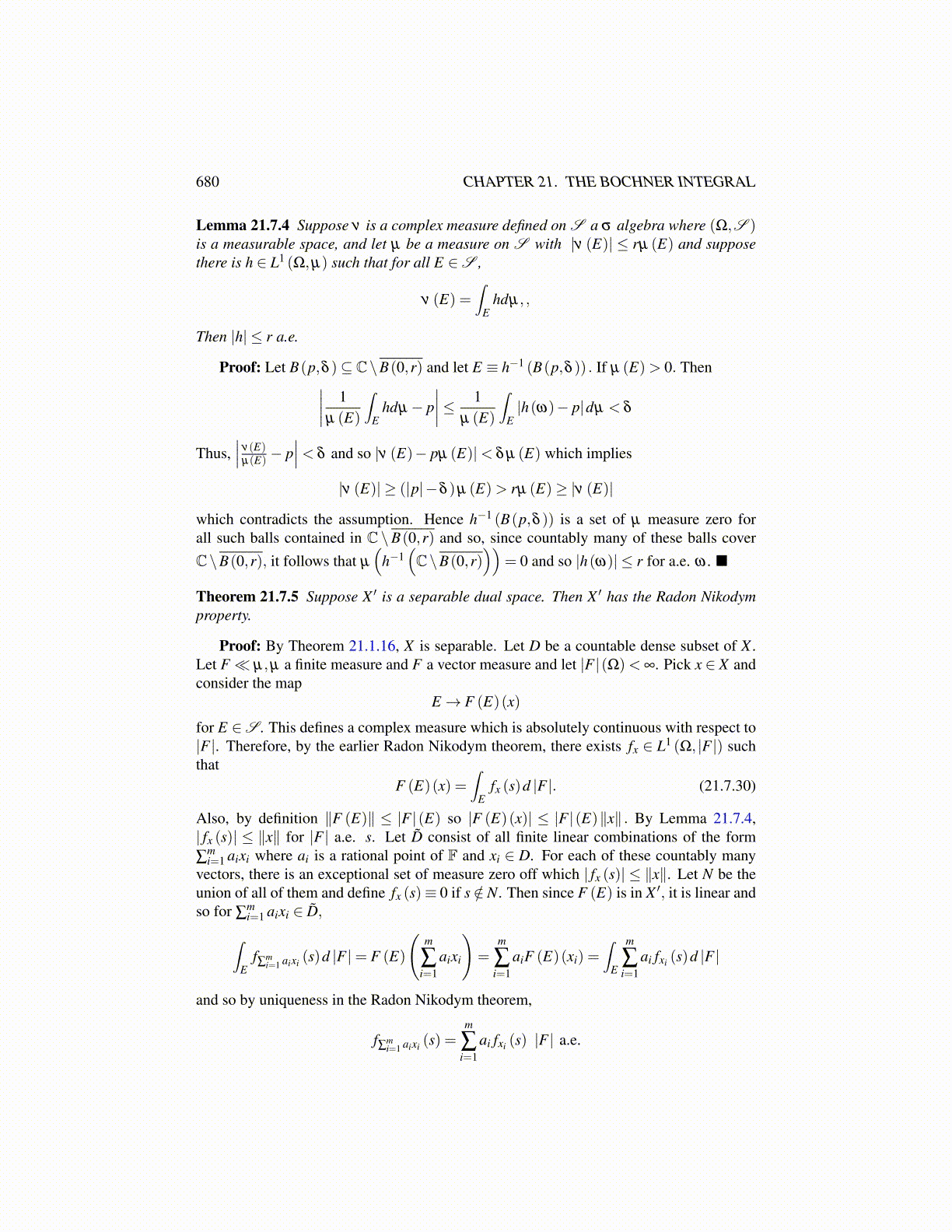
680 CHAPTER 21. THE BOCHNER INTEGRAL
Lemma 21.7.4 Suppose ν is a complex measure defined on S a σ algebra where (Ω,S )is a measurable space, and let µ be a measure on S with |ν (E)| ≤ rµ (E) and supposethere is h ∈ L1 (Ω,µ) such that for all E ∈S ,
ν (E) =∫
Ehdµ, ,
Then |h| ≤ r a.e.
Proof: Let B(p,δ )⊆ C\B(0,r) and let E ≡ h−1 (B(p,δ )) . If µ (E)> 0. Then∣∣∣∣ 1µ (E)
∫E
hdµ− p∣∣∣∣≤ 1
µ (E)
∫E|h(ω)− p|dµ < δ
Thus,∣∣∣ ν(E)
µ(E) − p∣∣∣< δ and so |ν (E)− pµ (E)|< δ µ (E) which implies
|ν (E)| ≥ (|p|−δ )µ (E)> rµ (E)≥ |ν (E)|
which contradicts the assumption. Hence h−1 (B(p,δ )) is a set of µ measure zero forall such balls contained in C \B(0,r) and so, since countably many of these balls coverC\B(0,r), it follows that µ
(h−1
(C\B(0,r)
))= 0 and so |h(ω)| ≤ r for a.e. ω .
Theorem 21.7.5 Suppose X ′ is a separable dual space. Then X ′ has the Radon Nikodymproperty.
Proof: By Theorem 21.1.16, X is separable. Let D be a countable dense subset of X .Let F≪ µ,µ a finite measure and F a vector measure and let |F |(Ω)< ∞. Pick x ∈ X andconsider the map
E→ F (E)(x)
for E ∈S . This defines a complex measure which is absolutely continuous with respect to|F |. Therefore, by the earlier Radon Nikodym theorem, there exists fx ∈ L1 (Ω, |F |) suchthat
F (E)(x) =∫
Efx (s)d |F |. (21.7.30)
Also, by definition ∥F (E)∥ ≤ |F |(E) so |F (E)(x)| ≤ |F |(E)∥x∥ . By Lemma 21.7.4,| fx (s)| ≤ ∥x∥ for |F | a.e. s. Let D̃ consist of all finite linear combinations of the form∑
mi=1 aixi where ai is a rational point of F and xi ∈ D. For each of these countably many
vectors, there is an exceptional set of measure zero off which | fx (s)| ≤ ∥x∥. Let N be theunion of all of them and define fx (s)≡ 0 if s /∈ N. Then since F (E) is in X ′, it is linear andso for ∑
mi=1 aixi ∈ D̃,∫
Ef∑
mi=1 aixi (s)d |F |= F (E)
(m
∑i=1
aixi
)=
m
∑i=1
aiF (E)(xi) =∫
E
m
∑i=1
ai fxi (s)d |F |
and so by uniqueness in the Radon Nikodym theorem,
f∑mi=1 aixi (s) =
m
∑i=1
ai fxi (s) |F | a.e.